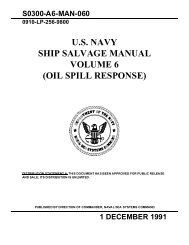FACEPLATE FNL (April 2004) - Supervisor of Salvage and Diving
FACEPLATE FNL (April 2004) - Supervisor of Salvage and Diving
FACEPLATE FNL (April 2004) - Supervisor of Salvage and Diving
Create successful ePaper yourself
Turn your PDF publications into a flip-book with our unique Google optimized e-Paper software.
Dive School at the Washington Navy Yard<br />
An Experimental <strong>Diving</strong> Organization<br />
was established at the New York<br />
Naval Shipyard in 1913 under the<br />
Comm<strong>and</strong> <strong>of</strong> Chief Gunner George D.<br />
Stillson. The organization was formally<br />
designated as the Navy Experimental<br />
<strong>Diving</strong> Unit (NEDU) in 1927 <strong>and</strong> was<br />
relocated to the Washington Navy Yard<br />
(WNY) to centralize all Navy research that<br />
related to diving. Relocating NEDU to<br />
close proximity with the Navy <strong>Diving</strong><br />
School ensured that the latest NEDU<br />
technology could be rapidly incorporated<br />
into the training procedures.<br />
The first Navy <strong>Diving</strong> School was<br />
established in 1926 in Building 146 at the<br />
Washington Navy Yard. The name was<br />
changed to Deep Sea <strong>Diving</strong> School<br />
(DSDS) in 1928. The Navy <strong>Salvage</strong> School<br />
was moved to the WNY from Bayonne, NJ<br />
in 1957 <strong>and</strong> combined with the DSDS.<br />
NEDU <strong>and</strong> DSDS were a joint comm<strong>and</strong><br />
until 1966 when they were separated, with<br />
NEDU comm<strong>and</strong>ed by an Engineering Duty<br />
Officer <strong>and</strong> DSDS under a <strong>Diving</strong> <strong>and</strong><br />
<strong>Salvage</strong> Officer. In 1970, Deep Sea <strong>Diving</strong><br />
School’s name was changed to the Naval<br />
School <strong>of</strong> <strong>Diving</strong> <strong>and</strong> <strong>Salvage</strong> (NSDS) to<br />
reflect its combined mission.<br />
The records indicate that Building 214<br />
was constructed in 1943 as the “U.S. Navy<br />
Experimental <strong>Diving</strong> Unit <strong>and</strong> Deep Sea<br />
Divers School.” The<br />
building was outfitted with<br />
multiple air <strong>and</strong> gas<br />
systems, four pressure<br />
complexes, <strong>and</strong> two open<br />
tanks to support NEDU <strong>and</strong><br />
DSDS. The diving barge<br />
TOM O’MALLEY <strong>and</strong><br />
various support craft were<br />
moored to the quay wall on<br />
the Anacostia River in front<br />
<strong>of</strong> the school. NEDU<br />
relocated to the Naval<br />
Coastal Systems Center in<br />
Panama City, Florida in 1975 <strong>and</strong> the <strong>Diving</strong><br />
School followed in 1980.<br />
During the 37 years <strong>of</strong> operation in<br />
Building 214 at the Washington Navy Yard,<br />
the school trained the Navy’s heliumoxygen<br />
mixed gas <strong>Diving</strong> Officers, <strong>Salvage</strong><br />
Officers, <strong>Diving</strong> Engineering Duty Officers,<br />
<strong>Diving</strong> Medical Officers, Master Divers,<br />
First Class Divers, <strong>and</strong> <strong>Diving</strong> Medical<br />
Technicians. The school also trained<br />
Divers from other branches <strong>of</strong> the American<br />
Armed Forces, numerous foreign countries,<br />
Department <strong>of</strong> Defense civilians, <strong>and</strong><br />
civilian law enforcement agencies.<br />
The school side <strong>of</strong> Building 214<br />
contained two pressure complexes for deep<br />
air <strong>and</strong> mixed-gas dives, <strong>and</strong> the open tanks<br />
for other underwater projects. The majority<br />
By: Lee Wolford<br />
Dive School History provided by<br />
Mr. Jim Dolph (dolphje@mail.ports.navy.mil).<br />
Barge TOM O’MALLEY at NEDU/NSDS at “The Yard.”<br />
<strong>of</strong> the training projects were accomplished<br />
in the Anacostia River diving from the<br />
barge TOM O’MALLEY. The river bottom<br />
mud varied in depth from mid-thigh to<br />
helmet, <strong>and</strong> visibility was nonexistent. The<br />
saying was: “If you can dive in the<br />
Anacostia, you can dive anywhere in the<br />
world.” This was especially true in<br />
February. The practical portion <strong>of</strong> the<br />
<strong>Salvage</strong> Course consisted <strong>of</strong> surveying,<br />
patching, pumping, <strong>and</strong> raising a sunken<br />
ship located near the Woodrow Wilson<br />
Bridge in Oxon Cove. Open water air <strong>and</strong><br />
mixed-gas dives were supported by an YDT<br />
moored over a 110-foot deep hole in the<br />
Potomac River <strong>of</strong>f Popes Creek, Maryl<strong>and</strong>.<br />
After NSDS moved to Panama City,<br />
Building 214 was demolished <strong>and</strong> replaced<br />
with a parking lot. The quayside where the<br />
TOM O’MALLEY was moored was<br />
refurbished <strong>and</strong> now has a railing, trees,<br />
<strong>and</strong> benches, but nothing acknowledging<br />
NSDS or NEDU on this site.<br />
In recognition <strong>of</strong> the accomplishments<br />
<strong>of</strong> all those who worked <strong>and</strong> trained at<br />
NSDS <strong>and</strong> the numerous advancements in<br />
diving that were perfected at NEDU, it is<br />
fitting that a suitable marker be erected here.<br />
The Comm<strong>and</strong>ant Naval District<br />
Washington is agreeable to this, if certain<br />
conditions are met. A design would have<br />
to be developed <strong>and</strong> submitted for<br />
approval <strong>and</strong> the project would have to be<br />
completed at no cost to the Navy.<br />
Lee Wolford was until recently a <strong>Salvage</strong><br />
Operations Specialist at NAVSEA 00C.<br />
A u g u s t 2 0 0 4 2 1

















